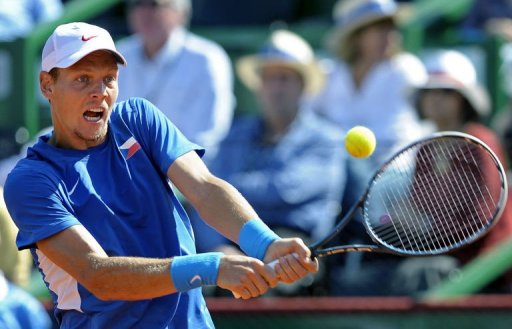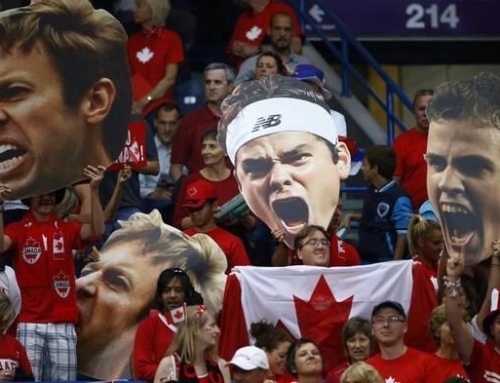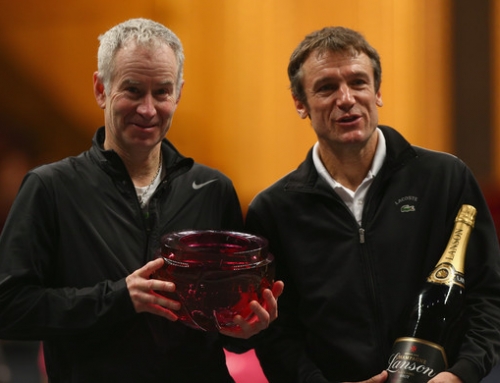 No one had expected the US to make it this far. In the opening round, the US was pitted against Switzerland, on clay, with Roger Federer playing, but Isner pulled a big upset, and the US got past them. Then, the US plays against France, at France, on clay, even though the French might actually be better on hard courts than clay. They win their too with a key wins by Isner who beat Gilles Simon and Jo-Wilfried Tsonga.
No one had expected the US to make it this far. In the opening round, the US was pitted against Switzerland, on clay, with Roger Federer playing, but Isner pulled a big upset, and the US got past them. Then, the US plays against France, at France, on clay, even though the French might actually be better on hard courts than clay. They win their too with a key wins by Isner who beat Gilles Simon and Jo-Wilfried Tsonga.
But Spain was going to present challenges. Even without Rafael Nadal, Spain is tough enough to put two top teams with players like Ferrer, Almagro, Verdasco, and Lopez in the top 30.
When Isner could not topple Almagro in a five-set marathon, US hopes were already in jeopardy. Querrey isn’t strong enough on clay to beat either Almagro or Ferrer, and Ferrer won in 4 sets over the American. The Bryan brothers took the doubles, as they normally do, but Isner, perhaps fatigued from his loss to Almagro, wasn’t ready to unseat Ferrer who took the match in four sets and secured Spain’s spot in the finals once again.
The other Davis Cup semi was being played in Argentina against the Czech Republic. David Nalbandian had to withdraw from the US Open, and besides, Monaco’s top ten ranking meant he was better suited to be in this round for Argentina.
del Potro had been advised by doctors to rest his left wrist (he had injured his right wrist which caused him to sit out most of 2010), but because Davis Cup was important, he chose to play, and beat Radek Stepanek. However, Berdych, who had been playing hot since the US Open, made the transition to clay and beat Juan Monaco.
Berdych and Stepanek then paired in doubles to take the critical middle tie. Stepanek has been playing a bit more doubles these days with Leander Paes, and the two have paired up enough ties. del Potro decided he was not well enough to play the reverse singles thus conceding the match. Carlos Berlocq filled in, but lost in straight sets. With the victory in hand, the Czechs played Ivo Minar in the meaningless fifth rubber and he lost to Monaco in straight sets.
Davis Cup had a bit of controversy with Kevin Anderson. Anderson wrote a letter on his blog explaining why he was not playing for South Africa. In the end, it boiled down to money. Anderson said he played Davis Cup for South Africa last year, got injured, and had no compensation for that. The tie was supposed to be played in South Africa against Canada, but South Africa couldn’t even afford to host the event, so Canada hosted the tie.
Anderson recently got married to an American he met while playing college tennis int he US and is South Africa’s best player, but he says it’s difficult for him to get endorsements because he lives primarily in the US, and this doesn’t make South African sponsors happy, so he primarily earns money by playing on the tour.
Canada won the relegation match rather handily lacking enough good players.
Not every team was playing in the World Group. Teams that lose in the opening round have to play a relegation round to qualify back to the main World Group. While Federer has often skipped playing Davis Cup in the World Group, he’s often there to play relegation rounds to prevent Switzerland from falling too far down. These are often played against weaker countries.
Federer had a relatively comfortable win over Thiemo de Bakker in straight sets while Stan Wawrinka beat Robin Haase in four sets. The two paired to play doubles, but lost, so Federer had to play reverse singles where he beat de Bakker in straight sets. Marco Chiudinelli played the fifth and meaningless rubber.
This puts Spain against Czech Republic at the Czech Republic. Both Berdych and Stepanek play better on fast surfaces, so they’ll likely put it on a fast indoor surface. Ferrer plays well on pretty much everything, but the faster the surface, the harder it is for him to play, and Berdych can overpower a player like Ferrer.
Of course, that match will be after the year-end championship in London, so there’s a chance Nadal could play too should he choose not to shut it down.
The big question is who to play in the next slot. Almagro, for such a big hitter, has not done that well on faster surfaces, although he did fairly well this year. Feliciano Lopez is Spain’s best fast court player outside of Nadal and Ferrer. Even Verdasco is pretty good on hard courts.
This will be Spain’s fourth appearance in the Davis Cup finals in the last 5 years, with the one other year going to Serbia in 2010.




![[Davis Cup, QF, Day 3] Raonic wins over Seppi, clinches tie to move to semis](https://www.essentialtennis.com/wp-content/uploads/2013/04/20130407milos-500x383.jpg)
![[Davis Cup QF, Day 2] North American teams go the distance in doubles](https://www.essentialtennis.com/wp-content/uploads/2013/04/20130406serb-500x383.jpeg)
![[Davis Cup, 1R] Sam Querrey wins fifth rubber to advance US past Brazil](https://www.essentialtennis.com/wp-content/uploads/2013/02/20130203sam-500x383.jpg)
